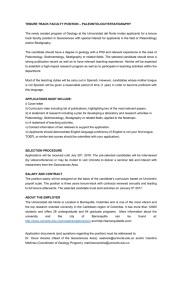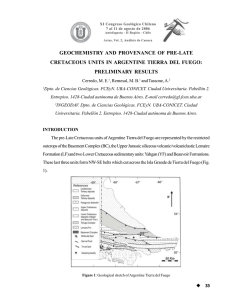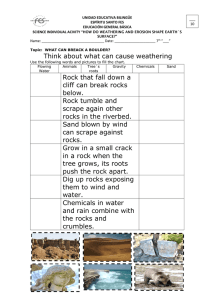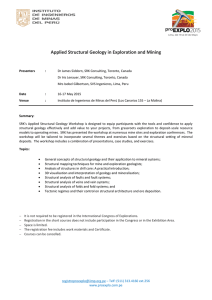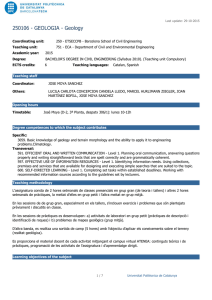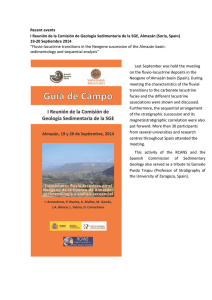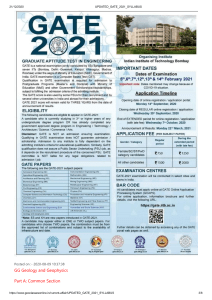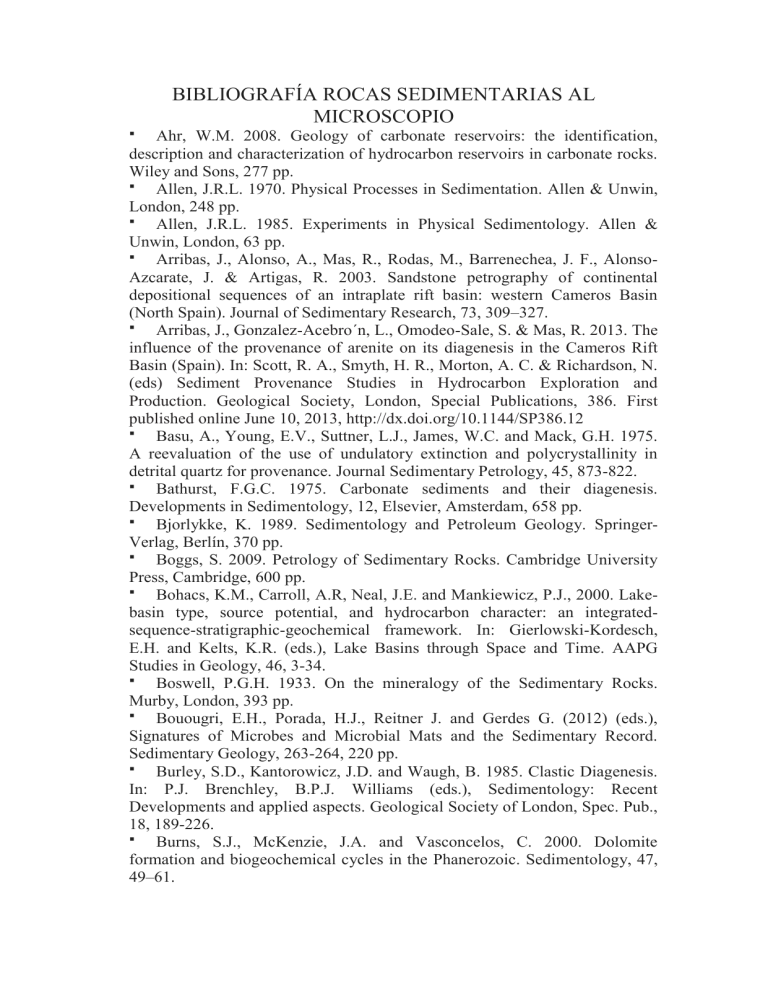
BIBLIOGRAFÍA ROCAS SEDIMENTARIAS AL MICROSCOPIO Ahr, W.M. 2008. Geology of carbonate reservoirs: the identification, description and characterization of hydrocarbon reservoirs in carbonate rocks. Wiley and Sons, 277 pp. Allen, J.R.L. 1970. Physical Processes in Sedimentation. Allen & Unwin, London, 248 pp. Allen, J.R.L. 1985. Experiments in Physical Sedimentology. Allen & Unwin, London, 63 pp. Arribas, J., Alonso, A., Mas, R., Rodas, M., Barrenechea, J. F., AlonsoAzcarate, J. & Artigas, R. 2003. Sandstone petrography of continental depositional sequences of an intraplate rift basin: western Cameros Basin (North Spain). Journal of Sedimentary Research, 73, 309–327. Arribas, J., Gonzalez-Acebro´n, L., Omodeo-Sale, S. & Mas, R. 2013. The influence of the provenance of arenite on its diagenesis in the Cameros Rift Basin (Spain). In: Scott, R. A., Smyth, H. R., Morton, A. C. & Richardson, N. (eds) Sediment Provenance Studies in Hydrocarbon Exploration and Production. Geological Society, London, Special Publications, 386. First published online June 10, 2013, http://dx.doi.org/10.1144/SP386.12 Basu, A., Young, E.V., Suttner, L.J., James, W.C. and Mack, G.H. 1975. A reevaluation of the use of undulatory extinction and polycrystallinity in detrital quartz for provenance. Journal Sedimentary Petrology, 45, 873-822. Bathurst, F.G.C. 1975. Carbonate sediments and their diagenesis. Developments in Sedimentology, 12, Elsevier, Amsterdam, 658 pp. Bjorlykke, K. 1989. Sedimentology and Petroleum Geology. SpringerVerlag, Berlín, 370 pp. Boggs, S. 2009. Petrology of Sedimentary Rocks. Cambridge University Press, Cambridge, 600 pp. Bohacs, K.M., Carroll, A.R, Neal, J.E. and Mankiewicz, P.J., 2000. Lakebasin type, source potential, and hydrocarbon character: an integratedsequence-stratigraphic-geochemical framework. In: Gierlowski-Kordesch, E.H. and Kelts, K.R. (eds.), Lake Basins through Space and Time. AAPG Studies in Geology, 46, 3-34. Boswell, P.G.H. 1933. On the mineralogy of the Sedimentary Rocks. Murby, London, 393 pp. Bouougri, E.H., Porada, H.J., Reitner J. and Gerdes G. (2012) (eds.), Signatures of Microbes and Microbial Mats and the Sedimentary Record. Sedimentary Geology, 263-264, 220 pp. Burley, S.D., Kantorowicz, J.D. and Waugh, B. 1985. Clastic Diagenesis. In: P.J. Brenchley, B.P.J. Williams (eds.), Sedimentology: Recent Developments and applied aspects. Geological Society of London, Spec. Pub., 18, 189-226. Burns, S.J., McKenzie, J.A. and Vasconcelos, C. 2000. Dolomite formation and biogeochemical cycles in the Phanerozoic. Sedimentology, 47, 49–61. Caracciolo, L., Arribas, J., Ingersoll, R. V. & Critelli, S. 2013. The diagenetic destruction of porosity in plutoniclastic petrofacies: the Miocene Diligencia and Eocene Maniobra formations, Orocopia Mountains, southern California, USA. In: Scott, R. A., Smyth, H. R., Morton, A. C. & Richardson, N. (eds) Sediment Provenance Studies in Hydrocarbon Exploration and Production. Geological Society, London, Special Publications, 386. First published online July 15, 2013, http://dx.doi.org/10.1144/SP386.9 Carozzi, A.V. 1960. Microscopic Sedimentary Petrography, Wiley, New York, 485 pp. Catuneanu, O. 2006. Principles of sequence stratigraphy. Elsevier, Amsterdam, 375 pp. Cherns, L. and Wright, V.P. 2009. Quantifying the impacts of early diagenetic aragonite dissolution on the fossil record. Palaios, 24, 756-771. Critelli, S. & Ingersoll, R. V. 1995. Interpretation of neovolcanic versus palaeovolcanic sand grains: an example from Miocene deep-marine sandstone of the Topanga Group (Southern California). Sedimentology, 42, 783–804. Critelli, S.&Le Pera, E. 1994. Detrital modes and provenance of Miocene sandstones and modern sands of the Southern Apennines thrust-top basins (Italy). Journal of Sedimentary Research, 64, 824–835. Critelli, S., Marsaglia, K. M. & Busby, C. J. 2002. Tectonic history of a Jurassic backarc-basin sequence (the Gran Canon Formation, Cedros Island, Mexico), based on compositional modes of tuffaceous deposits. Geological Society of America Bulletin, 114, 515–527. Crossey, L., Loucks, R. and Totten, M. 1996. Diagenesis and Fluid Flow: Concepts and Applications. Society for Sedimentary Geology, Special Publication, 55, 222 pp. Dickinson, W. R. 1970. Interpreting detrital modes of graywacke and arkose. Journal of Sedimentary Petrology, 40, 695–707. Dickinson, W. R. 1985. Interpreting provenance relations from detrital modes of sandstones. In: Zuffa, G. G. (ed.) Provenance of Arenites. Reidel, Dordrecht, 333–361. Dickinson, W. R. 1997. Tectonic implications of Cenozoic volcanism in coastal California. Geological Society of America Bulletin, 109, 936–954. Dickinson, W. R. & Snyder, W. S. 1978. Plate tectonics of the Laramide orogeny. In: Matthews, V. III. (ed.) Laramide Folding Associated with Basement Block Faulting in the Western United States. Geological Society of America, Memoir, 151, 355–366. Dott, R.H. 1964. Wacke, greywacke and matrix: what approach to immature sandstone classification? Journal Sedimentary Petrology, 34, 625632. Dunham, R.J. 1962. Classification of carbonate rocks according to depositional texture. Mem. Am. Assoc. Pet. Geol.,1, 108-121. Einsele, G. 2000. Sedimentary Basins – Evolution, Facies, and Sediment Budget. 2nd edn. Springer, Berlin. Embry, A. and Klovan, J.E. 1971. A late Devonian reef tract on northeastern Banks Island, Northwest Territories. BulletinCanadian Petroleum Geology, 19, 730-781. Engel, M.H. and Macko, S.A. 1993. Organic geochemistry: principles and applications. Plenum Press, New York, 861 pp. Flügel, E. 1982. Microfacies analysis of Limestones. Springer- Verlag, Berlín, 633 pp. Folk, R.L. 1959. Practical petrography classification of limestones. Springer Verlag, Berlín, 633 pp. Folk, R.L. 1962. Spectral subdivision of limestone types. Mem. Am. Assoc. Pet. Geol., 1, 62-84. Folk, R.L.1964. A review of Grain-size parameter. Sedimentology, 6, 7393. Folk, R.L. 1974. Petrology of sedimentary rocks. Hemphill Publ.co., Austin, 182 pp. Folk, R.L., Andrews, P & Lewis, D. W. 1970. Detrital sedimentary rock classification and nomenclature for use in New Zealand, New Zealand Journal of Geology and Geophysics, 13:4, 937-968, DOI: 10.1080/00288306.1970.10418211 To link to this article: https://doi.org/10.1080/00288306.1970.10418211 Friedman, G.M. (ed.) 1969. Depositional environments in carbonate rocks. SEMP Spec. Pub., 14, 209 pp. Friedman, G.V. and Sanders, J.E. 1978. Principles of Sedimentology. John Wiley & Sons, New York, 792 pp. Garzanti, E. 2019. Petrographic classification of sand and sandstone. Earth-science reviews, 192: 545-563. Gazzi, P. 1966. Le arenarie del flysch sopracretaceo dell’Appennino modenese; correlazioni con il Flysch di Monghidoro. Mineralogia e Petrografia Acta, 12, 69–97. García Garmilla, P. and Aranburu, A. 2008. Lucien Cayeux (1864-1944): un ilustre precursor en la enseñanza de la Petrología Sedimentaria. Geogaceta, 45, 111-114. Gerdes, G., Klenke, T. and Noffke, N. 2000. Microbial signatures in peritidal siliciclastic sediments, a catalogue. Sedimentology,47, 279-308. Giles, M.R. 1997. Diagenesis: a quantitative perspective: implications for basin modelling and rock property predict. Kubler Academic, Dordrecht, 526 pp. Harms, J.C., Southard, J.B. and Walker, R.G. 1982. Structures and sequences in clastic rocks. SEPM Short Course, 259 pp. Hjülstrom, F. 1935. Studies on the Morphological activity of rivers as Illustrated by River Fyris. Bulletin of the Geological Institute, Uppsala, 25, 221-527. Hutton, J. 1788. Theory of the Earth. Transactions of the Royal Society of Edinburgh, vol. I, Part II, 209-304. Ingersoll, R. V. 1990. Actualistic sandstone petrofacies: discriminating modern and ancient source rocks. Geology, 18, 733–736. James, N.P., Bone, Y. and Kyser T.K. 2005. Where has all the aragonite gone?: Mineralogy of Holocene neritic coolwater carbonates, southern Australia. Journal of Sedimentary Research, 75, 454–463. Killops, S. and Killops, V. 2005. Introduction to organic geochemistry. Blackwell Sci, Oxford, 393 pp. Krumbein, W.C. 1932. A history of the principles and methods of mechanical analysis. Journal Sedimentary Petrology, 2, 89-124. Krumbein, W.C. 1934. Size Frequency Distribution of Sediments. Journal Sedimentary Petrology, 4, 65-77. Krynine, P.D. 1948. The megascopic study and field classification of sedimentary rocks. Journal of Geology, 56, 130- 165. Land, L.S. 1998. Failure to precipitate dolomite at 25 °C from dilute solution despite 1000-fold oversaturation after 32 years. Aquatic Geochemistry, 4 (3), 361–368. Larsen,G. and Chilingar, G.V. (eds.) 1979. Diagenesis in sediments and sedimentary rocks. Developments in Sedimentology 25, Elsevier, Amsterdam, 579 pp. Larsen, G. and Chilingar, G.V. (eds.) 1983. Diagenesis in sediments and sedimentary rocks. 2. Developments in Sedimentology 25B, Elsevier, Amsterdam, 572 pp. Leeder, M.R. 1999. Sedimentology and Sedimentary Basins. Blackwell Science, Oxford, 592 pp. Limarino, C.O., Giordano, S.R., 2016. Unraveling multiple provenance areas using sandstone petrofacies and geochemistry: an example in the southern flank of the Golfo San Jorge Basin (Patagonia, Argentina). Journal of South American Earth Sciences 66, 208–231. Limarino, C.O., Giordano, S.R., Rodriguez Albertani, R.J., 2017. Diagenetic model of the Bajo Barreal Formation (cretaceous) in the southwestern flank of the golfo de San Jorge Basin (Patagonia, Argentina). Marine and Petroleum Geology: 88, 907–931. Limarino, C.O., Giordano, S., Rodriguez Albertani, R. Ciccioli, P. and Bodan, P. 2020. Patterns and origins of the porosity in the productive reservoirs of the upper part of the Chubut Group, southern flank of the Golfo de San Jorge Basin, Patagonia Argentina. Journal of South American Earth Sciences DOI: 10.1016/j.jsames.2019.102480 Lippmann, F. 1973. Sedimentary Carbonate Minerals. Springer, New York, 228 pp. Lokier, S., & Al Junaibi, M. 2016. The petrographic description of carbonate facies: are we all speaking the same language?. Sedimentology 63:1483-1885. https://onlinelibrary.wiley.com/doi/full/10.1111/sed.12293 Lowenstam H.A. and Weiner S., 1989. On Biomineralization.Oxford University Press, New York, 324 pp. Lyell, S.Ch. 1830-3. Principles of Geology. John Murray, London, 3 vol. MAIKLEM, W. R. (1968). SOME HYDRAULIC PROPERTIES OF BIOCLASTIC CARBONATE GRAINS. Sedimentology, 10(2), 101–109. doi:10.1111/j.13653091.1968.tb01102.x Mange, M. A. & Maurer, M. A. (eds) 1992. Heavy Minerals in Colour. Chapman & Hall, London. Mange, M. A. & Wright, D. T. (eds) 2007. Heavy Minerals in Use. Developments in Sedimentology, 58. Elsevier, Amsterdam. Mange, M., Idleman, B., Yin, Q.-Z., Hidaka, H. & Dewey, J. 2010. Detrital heavy minerals, white mica and zircon geochronology in the Ordovician South Mayo Trough, western Ireland: signatures of the Laurentian basement and the Grampian orogeny. Journal of the Geological Society, London, 167, 1147–1160. Marfil, R. and De la Peña, J.A. 1989. Diagénesis: Rocas siliciclásticas y rocas carbonáticas. In: Nuevas tendencias: Sedimentologia. A. Arche (Coord). C.S.I.C. Madrid, vol II, 343-427. Marsaglia, K. M. & Ingersoll, R. V. 1992. Compositional trends in arcrelated, deep-marine sand and sandstone: a reassessment of magmatic-arc provenance. Geological Society of America Bulletin, 104, 1637–1649. McConchie, D. M., and D. W. Lewis, 1980, Varieties of glauconite in late Cretaceous and early Tertiary rocks of the South Island of New Zealand, and new proposals for classification: New Zealand Journal of Geology and Geophysics, v. 23, p. 413437. http://www.tandfonline.com/doi/abs/10.1080/00288306.1980.10424113 McDonald, D.A. and Surdam, R.C. (eds.) 1984. Clastic Diagenesis. Memoir 37, American Association of Petroleum Geologists, Tulsa, OK, 434 pp. McIlreath, I.A. and Choquette, D.V. (eds.) 1990. Diagenesis. Geoscience, Canada, Reprint Series 4, 338 pp. Miall, A.D., 1985. Architectural-element analysis: A new method of facies analysis applied to fluvial deposits. Earth-Science Reviews, 22, 261-308. Miall, A.D. 1999. Principles of sedimentary basin analysis. Third edition, Springer-Verlag Inc., New York, 616 pp Moore, C.H. 1989. Carbonate Diagenesis and Porosity. Developments in Sedimentology, 46, Elsevier, 338 pp. Moore, C.H. 2001. Carbonate Reservoirs. Porosity Evolution and Diagenesis in Sequence Stratigraphy Framework. Developments in Sedimentology, 55, Elsevier, Amsterdam, 444 pp. Morad, S. 1998. Carbonate cementation in sandstones: distribution patterns and geochemical evolution. In: Morad, S. (ed.) Carbonate Cementation in Sandstones, International Association of Sedimentologists Special Publications, 26, 1–26. Morad, S., Ben Ismail, H., De Ros, L. F., Al-Aasm, I. S. & Serrhini, N. E. 1994. Diagenesis and formation water chemistry of Triassic reservoir sandstones from southern Tunisia. Sedimentology, 41, 1253–1272. Morad, S., Ketzer, J. M.&De Ros, F. 2000. Spatial and temporal distribution of diagenetic alterations in siliciclastic rocks: implications for mass transfer in sedimentary basins. Sedimentology, 47, 95–120. Morad, S., Al-Ramadan, K., Ketzer, J. M. & De Ros, L. F. 2010. The impact of diagenesis on the heterogeneity of sandstone reservoirs: a review of the role of depositional facies and sequence stratigraphy. American Association of Petroleum Geologists Bulletin, 94, 1267– 1309, http://dx.doi.org/10.1306/04211009178 Moraes, M. A. S. & De Ros, L. F. 1990. Infiltrated clays in fluvial Jurassic sandstones of Recoˆncavo Basin, northeastern Brazil. Journal of Sedimentary Petrology, 60, 809–819. Moraes, M. A. S. & De Ros, L. F. 1992. Depositional, infiltrated and authigenic clays in fluvial sandstones of the Jurassic Sergi formation, Recoˆncavo Basin, northeastern Brazil. In: Houseknecht, D. W. & Pittman, E. P. (eds) Origin, Diagenesis and Petrophysics of Clay Minerals in Sandstone. Society for Sedimentary Geology (SEPM) Special Publications, Tulsa, 47, 197–208. Mount, J. 1985. Mixed siliciclastic and carbonate sediments: a proposed first-order textural and compositional classification. Sedimentology 32: 435442. Mount, J. F. 1984. Mixing of siliclastic and carbonate sediments in shallow shelf environments. Geology, 12, 432-435, Boulder. Munnecke, A. and Westphal, H. 2005. Variations in primary aragonite, calcite, and clay in fine grained calcareous rhythmites of Cambrian to Jurassic age: An environmental archive?. Facies, 51, 592–607. Noffke, N., Gerdes, G., Klenke, T. and Krumbein, W.E. 2001. Microbially induced sedimentary structures – a new category within the classification of primary sedimentary structures. Journal Sedimentary Petrology A71, 649– 656. Okada, H. and Kenyon-Smith, A. 2009. The birth of sedimentology: Henry Clifton Sorby and Johannes Walther. Geology Today, 25, 211-216. Ollier, C. 1984. Weathering. Olive & Boyd. 2ª ed., Longman, New York, 270 pp. Ortí, F. 1989. Evaporitas Marinas. In: Arche, A. (ed.), Sedimentologia. CSIC, 89-177. Pettijohn, F.J. 1949. Sedimentary rock. Harper & Brothers, New York, 526 pp. Pettijohn, F.J. 1975. Sedimentary rocks. An Introduction. Harper & Row, Pub. New York, 628 pp. Pettijohn, F. J., Potter, P. E. & Siever, R. 1972. Sand and Sandstone. Springer-Verlag, New York. Prothero, D.R. and Schwab, F. 2004. Sedimentary Geology. An Introduction to Sedimentary Rocks and Stratigraphy. W.H. Freeman and Co. New York, 557 pp. Reading, H.G. 1986. Sedimentary Environments and Facies. Blackwell Sci. Pub., Oxford, 615 pp. Scasso, R.A. y Limarino, C.O., 1997. Petrología y diagénesis de rocas clásticas. Asociación Argentina de Sedimentología, Publicación Especial Nº 1. Buenos Aires, Argentina. 259 pp. Schneiderman, N. and Harris, P.M. (eds.) 1985. Carbonate Cements. SEMP Spec. Pub, 36, 379 pp. Scholle, P. and Schluger, P.R. 1979. Aspects of Diagenesis. SEMP Spec. Pub., 26, 443 pp. Scholle, P.A., Bebout, C.G. and Moore, C.H. (eds.) 1983. Carbonate Depositional Environments. AAPG Memoir, 33, 708 pp. Scholle, P.A. and Spearing, D. (eds.) 1982. Sandstone depositional environments. AAPG Memoir , 31, Tulsa, 410 pp. Scholle, P.A. and Ulmer-Scholle D.S. 2003. A color guide to the petrography of carbonate rocks: grains, textures, porosity, diagenesis. AAPG Memoir, 77, 474 pp. Schreiber, B.C. (ed.) 1988. Evaporites and hydrocarbons. Columbia University Press, New York, 474 pp. Scoffin, T.P. 1987. An introduction to carbonate sediments and rocks. Blakie, Glasgow, 274 pp. Seckbach, J. and Oren, A. 2010. Microbial Mats: Modern and Ancient Microorganisms in Stratified Systems. Springer, Dordrech, 606 pp. Seibold, E. and Seibold, I. 2002. Sedimentology: from single grains to recent and past environments: some trends in sedimentology in the twentieth century. In: Oldroyd, D.R. (ed.). The Earth Inside and Out: Some Major Contributions to Geology in the Twentieth Century. Geol. Soc. London, Spec. Publ 192, 241-250. Sessa, J.A., Patzkowsky, M.E. and Bralower, T.J. 2009. The impact of lithification on the diversity, size distribution, and recovery dynamics of marine invertebrate assemblages. Geology, 37, 115–118. Shukla, V. and Baker, P.A. (eds.) 1988. Sedimentology and Geochemistry of Dolostones. SEMP Spec. Pub., 43, 266 pp. Stonecipher, S.A. 2000. Applied sandstone diagenesis: practical petrographic solutions for a variety of common exploration, development and production problems. SEPM,Tulsa, OK, U.S.A., 146 pp. Suess, E. and Fütterer, D. 1972. Aragonitic ooids: experimental precipitation from seawater in the presence of humic acid. Sedimentology, 19, 129–139. Taylor, T.R., Giles, M.R., Hathon, L.A., Diggs, T.N., Braunsdorf, N.R., Birbiglia, G.V., Kittridge, M.G., Macaulay, C.I. and Espejo, I.S. 2010. Sandstone diagenesis and reservoir quality prediction: Models, myths, and reality. AAPG Bulletin, 94, 1093–1132. Tissot, B.P. and Welte, D.H. 1984. Petroleum formation and occurrence. Springer-Verlag, Berlín, 699 pp. Tucker, M.E. 1991. Sedimentary Petrology. An Introduction to the origin of sedimentary rocks. (2ª ed.). Blackwell Sci. Publ, Oxford, 269 pp. Tucker, M.E. 2001. Sedimentary Petrology. An Introduction to the origin of sedimentary rocks. (3ª ed.). Blackwell Sci. Publ, Oxford, 262 pp. Tucker, M.E. and Wright, V.P. 1991. Carbonate Sedimentology. Blackwell Sci. Publ. Oxford, 482 pp. Tucker, M.E. and Bathurst, R.G.C. (eds.)1990. Carbonate Diagenesis. Int. Ass. Sedim. Reprint Series. 1, 312 pp. Udden, J.A. 1899. Mechanical composition of wind deposits. Augustana Library, 1, 69 pp. Ulmer-Scholle, D., Scholle, P., Schieber, J., and Raine, R., 2015. AAPG Memoir 109: A Color Guide to the Petrography of Sandstones. 509 pp. Vail, P.R., Mitchum, R.M. Jr., Todd, R.G., Widmier, J.M., Thompson, S.III., Sangree, J.B., Bubb, J.N. and Hatlelid, W.G. 1977. Seismic stratigraphy and global changes of sea level. In: Payton, C.E. (ed.), Seismic Stratigraphy – Applications to Hydrocarbon Exploration. AAPG Memoir, 26, 49–212. Vasconcelos, C. and McKenzie, J.A. 1997. Microbial mediation of modern dolomite precipitation and diagenesis under anoxic conditions (Lagoa Vermelha, Rio de Janeiro, Brazil). Journal of Sedimentary Research 67, 378– 390. Visher, G.S. 1969. Grain Size Distribution and Depositional Processes. Journal Sedimentary Petrology, 39, 1074-1106. Wadell, H. 1932. Sedimentation and Sedimentology. Science,75, 20. Wadell, H. 1935. Volume, shape and roundness of quartz particles. Journal of Geology, 43, 250-280. Walker, R.G. (ed.) 1984. Facies Models. Geoscience Canada, Reprint Series 1, 317 pp. Walter, L.M. and Morse, J.W. 1985. The dissolution kinetics of shallow marine carbonates in seawater: a laboratory study. Geochimica et Cosmochimica Acta, 49, 1503-1513. Warren, J.K. 1989. Evaporite Sedimentology: Importance in Hydrocarbon Accumulation. Prentice Hall, Englewood Cliffs, NJ, 285 pp. Warren, J.K. 2006. Evaporites: Sediments, Resources and Hydrocarbons. Springer. 1036 pp. Wentworth, C.K. 1922. A scale of grade and class terms for clastic sediments. Journal of Geology, 30, 377-392. Wilson, J.L. 1975. Carbonate Facies in Geologic History. SpringerVerlag, New York, 471 pp. Worden, R.H. & Morad, S. 2003. Clay minerals in sandstones: controls on formation, distribution and evolution. In: Worden, R. H. & Morad, S. (eds) Clay Mineral Cements in Sandstones. International Association of Sedimentologists Special Publications, 34, 3–41. Wright, V.P. 1992. A revised classification of limestones. Sedimentary Geology, 76, 177-185. Zenger, D.H., Dunham, J.B. and Ethington, R.L. (eds.) 1980. Concepts and Models of Dolomitization. SEMP Spec. Pub., 28, 320 pp. Zuffa, G.G. 1980. Hybrid arenites: their composition and classification. Journal Sedimentary Petrology, 50, 21-29. Zuffa, G.G. (ed.) 1985. Provenance of arenites. Nato Asi Series, Reidel, Dordrecht, 408 pp. Zuffa, G. G. 1985. Optical analyses of arenites: influence of methodology on compositional results. In: Zuffa, G. G. (ed.) Provenance of Arenites. Reidel, Dordrecht, 165–189. Zuffa, G. G. 1987. Unravelling hinterland and offshore palaeogeography from deep-water arenites. In: Leggett, J. K. & Zuffa, G. G. (eds) Marine Clastic Sedimentology. Graham and Trotman, London, 39–61.


